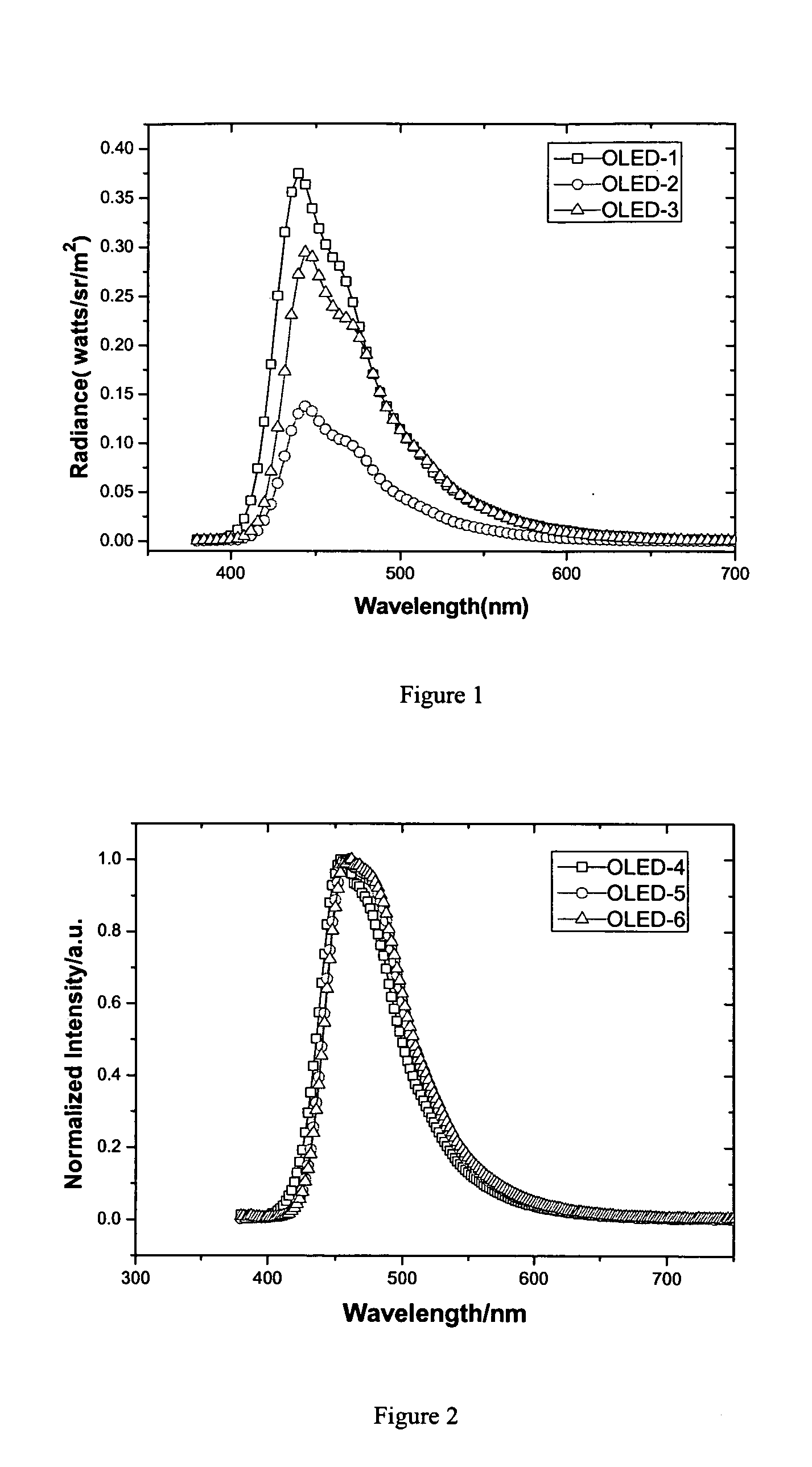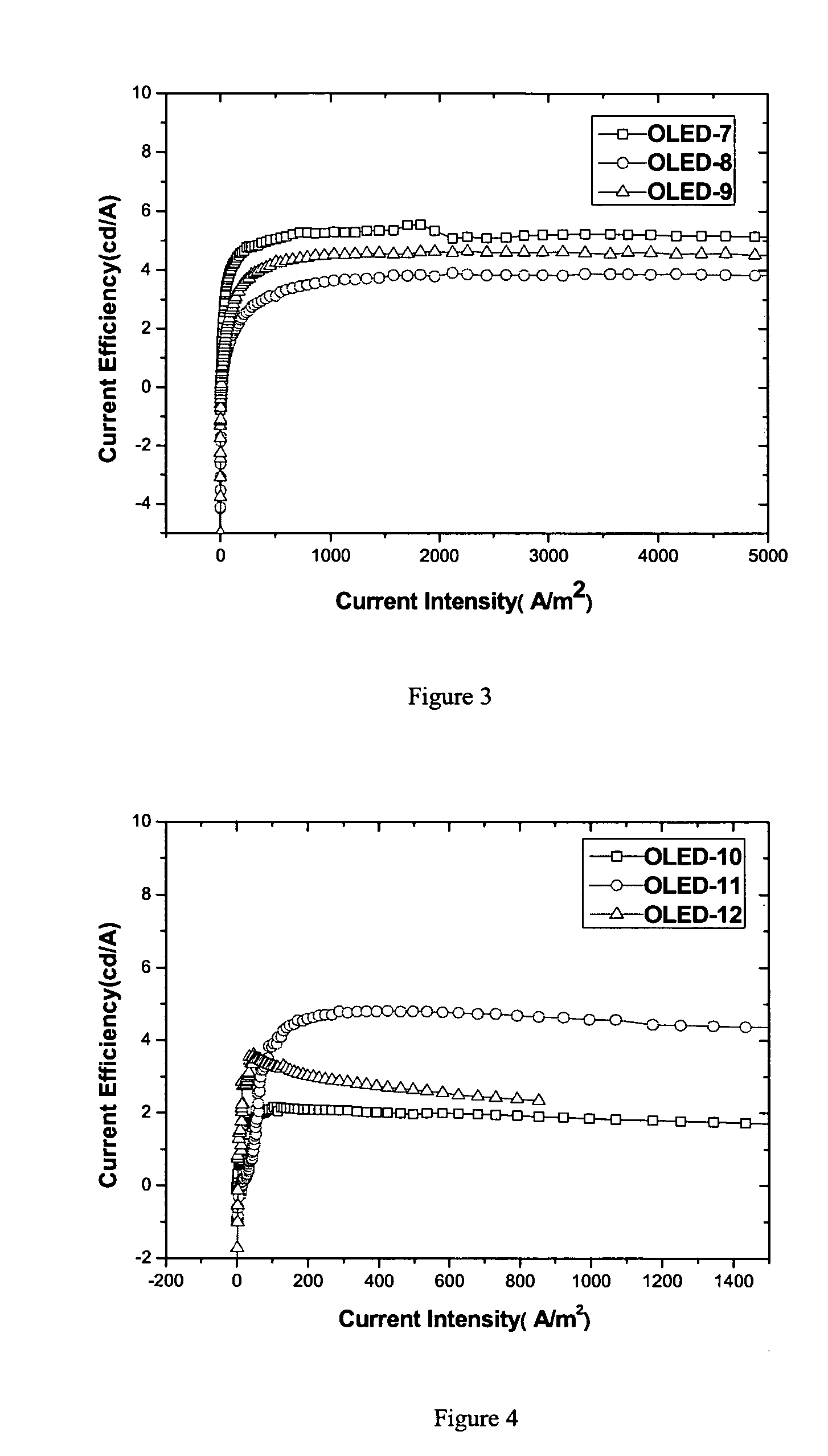Dinaphthyl ethylene derivativce, process for preparing it, film prepared from it, and OLED including the film
a technology of ethylene derivativce and ethylene ethylene, which is applied in the field of ethylene derivativce, can solve the problems of reducing the current efficiency of oled, too small bridge, and failing to attract sufficient human attention, etc., and achieves excellent performance, high luminescent efficiency, and high color purity.
- Summary
- Abstract
- Description
- Claims
- Application Information
AI Technical Summary
Benefits of technology
Problems solved by technology
Method used
Image
Examples
example 1
[0068]Synthesis of Compound C1
[0069]Synthesis of intermediate C1-1: To a three-necked flask (500 ml) was added 2-bromothiophene (16.30 g, 100 mmol), phenyl boronic acid (15.24 g, 125 mmol), Palladium (II) acetate (0.22 g, 1 mmol), triphenyl phosphine (0.53 g, 2 mmol), potassium carbonate (34.50 g, 250 mmol) and toluene (250 ml) under nitrogen with a magnetic stirring. The resulting mixture was heated under reflux for 4 hours, and then cooled to room temperature , and poured into a silica gel column (15 cm), eluted with petroleum ether. The solvent was removed by vacuum distillation to afford C1-1 (14.2 g).
[0070]Synthesis of intermediate C1-2: To a three-necked flask (250 ml) was added 2-phenylthiophene (8.01 g, 50 mmol) and anhydrous THF (100 ml) under a flow of argon with magnetic stirring. The resulting mixture was cool to −78□ with an ethanol-liquid nitrogen bath. To this mixture was added n-BuLi solution in n-hexane (2.5M, 24 mL, 60.0 mmol) dropwise; then stirring was continued ...
example 2
[0073]Synthesis of Compound C12
[0074]Synthesis of intermediate C12-1: To a three-necked flask (250 ml) was added 2-bromoindole (7.00 g, 35.7 mmol), copper acetate (0.8 g, 4.8 mmol), 2,4-dimethylpyridine (2 mL), myristic acid (1.104 g, 4.8 mmol), phenyl boronic acid (5.8 g, 48 mmol) and toluene (100 mL) under a ambience of oxygen and then magnetic stirred for 24 hours. The mixture was filtered by a short silica gel column to remove the black mass, and the filtrate was evaporated under reduced pressure. The residue was crystallized from petroleum ether to afford a white crystal C12-1 (5.8 g).
[0075]Syntheses of C12-2, C12-3 and C12: the processes were the same as example 1, finally affording a yellow solid C12 (2.4 g).
MS (m / e) of compound C:662;Elemental analysisCalculated C: 90.59%, H: 5.13%, N: 4.22%;(C50H34N2):Found C: 90.60%, H: 5.17%, N: 4.23%.
example 3
[0076]Synthesis of Compound C19
[0077]Synthesis of intermediate C19-1: To a three-necked flask (500 mi) was added 2-bromo-5-iodothiophene (28.9 g, 100 mmol), N-phenyl-2-naphthalamine (24.1 g, 110 mmol), cuprous iodide (1.9 g, 10 mmol), anhydrous potassium phosphate (53 g, 200 mmol), and o-xylene (250 ml) under nitrogen protection and heated to reflux with magnetic stirring for 24 hour. The mixture was cooled to room temperature, and filtered under reduced pressure. The solvent was removed from the filtrate by vacuum distillation. The crude product was purified by a silica gel column, eluted with petroleum ether to afford C19-1 (19.6 g).
[0078]The following process was the same as example 1, to afford compound C19 (1.2 g).
MS (m / e) of compound C:879;Elemental analysisCalculated C: 84.70%, H: 4.82%, S: 7.29, N: 3.19%;(C62H42S2N2):Found C: 84.71%, H: 4.78%, S: 7.31%, N: 3.20%.
PUM
| Property | Measurement | Unit |
|---|---|---|
| driving voltage | aaaaa | aaaaa |
| driving voltage | aaaaa | aaaaa |
| thickness | aaaaa | aaaaa |
Abstract
Description
Claims
Application Information
 Login to View More
Login to View More - R&D
- Intellectual Property
- Life Sciences
- Materials
- Tech Scout
- Unparalleled Data Quality
- Higher Quality Content
- 60% Fewer Hallucinations
Browse by: Latest US Patents, China's latest patents, Technical Efficacy Thesaurus, Application Domain, Technology Topic, Popular Technical Reports.
© 2025 PatSnap. All rights reserved.Legal|Privacy policy|Modern Slavery Act Transparency Statement|Sitemap|About US| Contact US: help@patsnap.com



